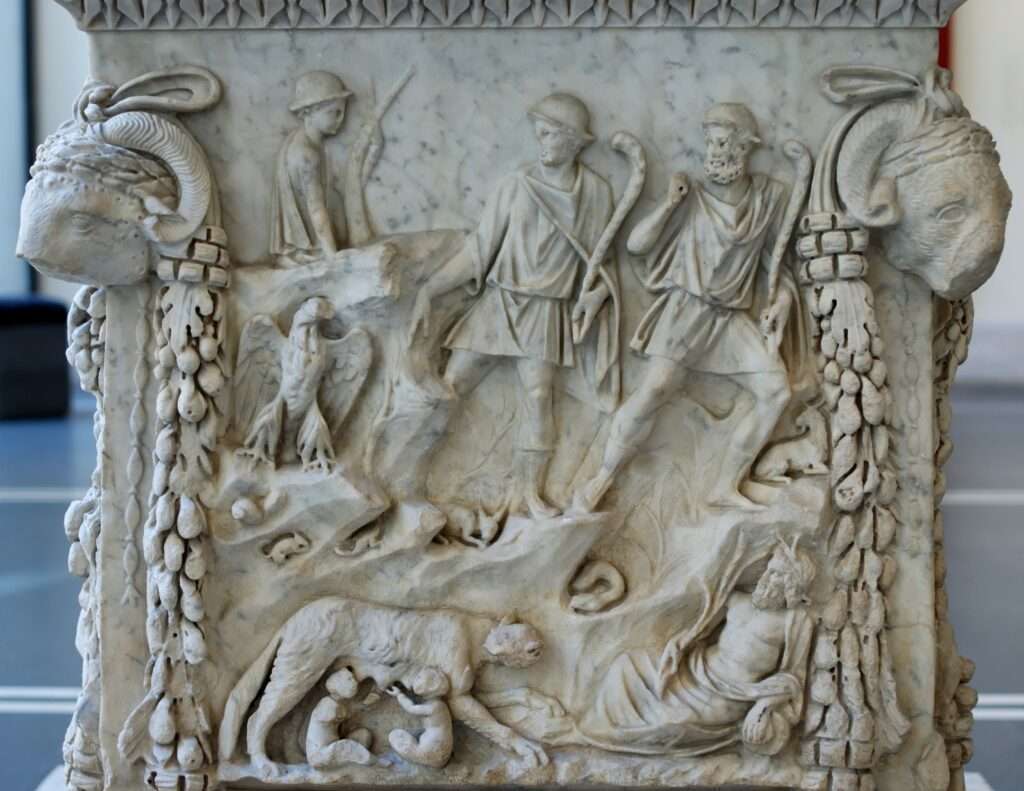The Lupercal is said to be a cave where a she-wolf suckled the legendary founder of Rome, Romulus, and his brother Remus.
It would not be easy to describe the cave’s location and the importance of some details surrounding the legend of twin brothers Romulus and Remus without mentioning their origin story.
The twins were the sons of Rhea Silvia and the god Mars. They were the grandsons of Numitor, the rightful king of nearby Alba Longa. Numitor himself was a descendant of the Hero Aeneas (of Trojan War fame). By extension, this made the twins descendants of those who fought in the Trojan War.

(note the she-wolf with the twins at the bottom)
King Numitor’s brother ousted Numitor from his throne, killed his sons, and made his daughter, Rhea Silvia, a Vestal Virgin, meaning she had to live a life of celibacy. However, when she became pregnant (she said that the god Mars had visited her), she was imprisoned, and when the twins were born, they were cast out to the Tiber River.
However, a flooding of the Tiber meant that those tasked with dumping the twins into the Tiber could not reach the river and instead cast them out in the overflow. As the overflow receded, the cradle that the twins were in was stopped by a fig tree.
It is here that the legendary she-wolf found them and suckled them. Nearby farmers spotted what was happening, picked up the two babies, and raised them as their own.
Livy describes the fig tree as a Ficus Ruminalis in his book, The History of Rome, Book I, IV.IV:
“Those who were carrying the children expected that this stagnant water would be sufficient to drown them, so under the impression that they were carrying out the king’s orders, they exposed the boys at the nearest point of the overflow, where the Ficus Ruminalis (said to have been formerly called Romularis) now stands.”
The present tense that Livy uses when describing the fig tree as ‘now stands’ has us believe that the tree was around in his lifetime (59 BC–AD 17).
Plutarch confirms this in the following passage of his book, The Parallel Lives – The Life of Romulus, IV.I, while also stating that the Latins believe that Mars is, in fact, the father of the twins:
“Now there was a wild fig tree hard by, which they called Ruminalis, either from Romulus, as is generally thought, or because cud-chewing, or ruminating, animals spent the noon-tide there for the sake of the shade, or best of all, from the suckling of the babes there; for the ancient Romans called the teat “ruma,” and a certain goddess, who is thought to preside over the rearing of young children, is still called Rumilia, in sacrificing to whom no wine is used, and libations of milk are poured over her victims. Here, then, the babes lay, and the she-wolf of the story here gave them a suck, and a woodpecker came to help in feeding them and to watch over them. Now, these creatures are considered sacred to Mars, and the woodpecker is held in special veneration and honor by the Latins, and this was the chief reason why the mother was believed when she declared that Mars was the father of her babes.”
According to legend, the Lupercal was a cave located at the southwest foot of Palatine Hill, opposite the Circus Maximus. While the exact location has not been determined yet, ancient sources knew where it was.

(Palatine Hill & Circus Maximus located in the middle about two-thirds down)
Dionysius of Halicarnassus gives us a good description of the Lupercal and what was surrounding it in his book, Roman Antiquities, Book I, XXXII.IV, allowing the reader to imagine what it would have looked like. He also begins to give a hint as to the location of the Lupercal:
“This place the Romans call the Lupercal, but we should call it Lykaion or “Lycaeum.” Now, it is true, since the district about the sacred precinct has been united with the city, it has become difficult to make out by conjecture the ancient nature of the place. Nevertheless, at first, we are told, there was a large cave under the hill overarched by a dense wood; deep springs issued from beneath the rocks, and the glen adjoining the cliffs was shaded by thick and lofty trees. In this place they raised an altar to the god and performed their traditional sacrifice, which the Romans have continued to offer up to this day in the month of February, after the winter solstice, without altering anything in the rites then performed. The manner of this sacrifice will be related later. Upon the summit of the hill they set apart the precinct of Victory and instituted sacrifices to her also, lasting throughout the year, which the Romans performed even in my time.”
Dionysius also records the most concise description of the Lupercal being located at the southwest foot of the Palatine Hill later in his book, Book I, LXXIX.VII. The lead-up to the below quote in Dionysius recalling the origin story of Romulus and Remus:
“The wolf, however, far from being provoked at the approach of the men, but as if she had been tame, withdrew gently from the babes and went away, paying little heed to the rabble of shepherds. Now there was not far off a holy place, arched over by a dense wood, and a hollow rock from which springs issued; the wood was said to be consecrated to Pan, and there was an altar there to that god. To this place, then, the wolf came and hid herself. The grove, to be sure, no longer remains, but the cave from which the spring flows is still pointed out, built up against the side of the Palatine hill on the road which leads to the Circus, and near it is a sacred precinct in which there is a statue commemorating the incident; it represents a she-wolf suckling two infants, the figures being in bronze and of ancient workmanship.”
Like the Casa Romuli, the Lupercal was still known in the late stages of the Roman Empire, either through the preservation of the site or something commemorating it. The early fifth-century document The Regionaries—Regio X Palatium, XV, lists the Lupercal as ‘lupercam’.
Excavation work was conducted in 2007, and archeologists believed that they had discovered the Lupercal, one of the most consequential locations in the history of this ancient civilization, under the Palatine Hill. However, this has been rather inconclusive, with many people believing it was a nymphaeum from the time of Emperor Nero.
Sources:
Plutarch – The Life of Romulus (Thayer) – https://penelope.uchicago.edu/Thayer/E/Roman/Texts/Plutarch/Lives/Romulus*.html#4
Dionysius of Halicarnassus – Roman Antiquities (Thayer) – https://penelope.uchicago.edu/Thayer/E/Roman/Texts/Dionysius_of_Halicarnassus/1B*.html
The Regionaries (Thayer) – https://penelope.uchicago.edu/Thayer/L/Gazetteer/Places/Europe/Italy/Lazio/Roma/Rome/_Texts/Regionaries/text*.html
Livy – The History of Rome (Perseus Digital Library) – https://www.perseus.tufts.edu/hopper/text?doc=Perseus%3Atext%3A1999.02.0026%3Abook%3D1%3Achapter%3D4
Featured image – By Rosemania – https://www.flickr.com/photos/rosemania/5384048970, CC BY 2.0

